Anmeldelse av Once Upon A Katamari
Once Upon A Katamari Review lands at a moment when many long-running series chase reinvention or spectacle to justify their return. This one chooses steadiness. It brings the rhythmic absurdity, the cheerful excess, and the strange serenity that defined Katamari in its early years, while layering in smart tweaks and broader scale. It is less a reinvention than a confident re-centering, treating the original idea as strong enough to stand with only careful additions. The result is a game that rolls forward with purpose, rarely straining for effect, never losing sight of the charm built into its humble premise.
This post draws on Charlie Wacholz’s review on IGN, which framed the new entry through its relationship to the series’ history and playful tonal balance across worlds, music, and movement. Wacholz noted a striking tonal consistency.
“The first new mainline Katamari game in 14 years doesn’t try to reinvent the misshapen mass of things you roll around, and that’s fine by me, because Katamari doesn’t need fixing.” — Charlie Wacholz
The opening hours make that position easy to understand. The once-novel premise still feels distinct today. Objects scatter across apartments, streets, and historical backdrops in painterly clusters, waiting to be absorbed into a ball that grows from toy scale to catastrophe scale in minutes. The humor lands with simple timing. The omnipotent, vainglorious King of All Cosmos remains both benevolent and ridiculous, and his universe-toppling accident here is delivered with a breezy confidence that reminds players how thin the narrative always has been by design. Yet thin does not mean careless. A tone like this takes judgment to sustain, and the comedy arrives with calm precision rather than manic overproduction.
Wacholz described humor as rooted in economy and rhythm rather than volume. “Making the most of every last syllable of dialogue, I chuckled at least once just about every time he mused on the nature of the universe or paid himself a compliment.” — Charlie Wacholz
That line captures the broader achievement: restraint fuels impact. Visual jokes and environmental storytelling stay quick and light. Dogs wander ancient marketplaces in armor. Bizarre vignettes play out in the corner of the screen and vanish again. The game never forces attention to a punchline, trusting the player to notice what they notice, and the sense of surprise does more work than any scripted escalation could.
Levels run across eras, from prehistoric wilderness to stylized versions of classical civilizations. Interaction remains rooted in familiar movement, with the rolling mechanic still demanding a steady, two-stick rhythm that feels distinct from modern analog expectations. Early tests emphasize delicacy, then tilt toward controlled frenzy as each stage compounds scale. It remains accessible but benefits from practiced intuition. When the ball grows large enough to treat buildings as confetti and monuments as toys, the speed at which perspective shifts remains uniquely satisfying.
The structure around these spaces is more generous than the PlayStation 2 era entries, yet it stays tight. Objectives range from simple size goals to theme-based collections. Challenges play with ingredients, animals, sweets, or cultural ephemera, and the cadence between clarity and chaos feels natural. When the pace breaks for moments of puzzle-like navigation, the shift refreshes rather than interrupts.
“Katamari’s newest custodians toy with the formula with careful precision.” — Charlie Wacholz
He pointed to new power-ups as small but thoughtful additions, using examples like a limited rocket burst to cut through wind resistance or a radar to target specific items during themed tasks. Nothing rewrites the series foundation. Instead, each layer broadens what can exist inside the formula without changing the formula itself. That approach shows confidence and an understanding of what makes Katamari Katamari.
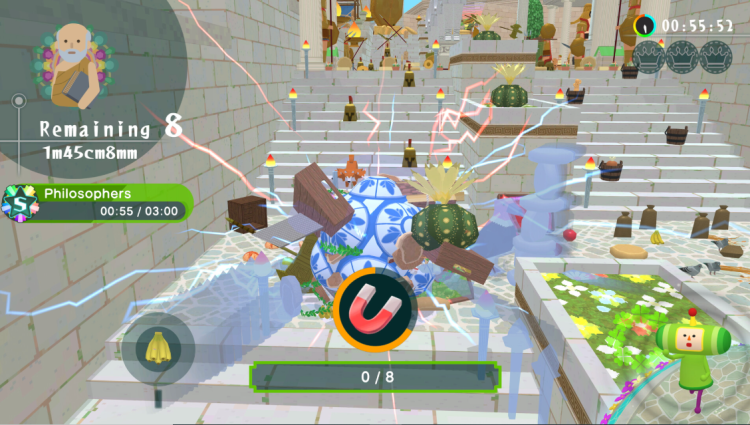
The competitive mode embodies a similar logic. Players still battle by gathering objects faster than rivals, yet the deposit-for-points system asks for planning rather than pure momentum. There is a mild party-game cadence to the scoring adjustments at the end, and while the change is modest, it strengthens a mode that often felt throwaway in earlier entries. Co-op, the beloved two-player single-katamari challenge, does not return here, and some long-time fans will miss it. Even so, the competitive structure carries more energy than before, enough to suggest this corner of the series could continue growing.
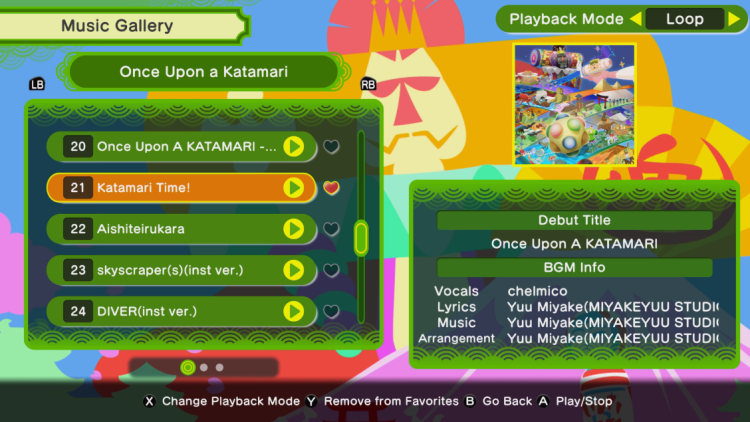
Presentation plays a major role. Visuals lean into bold color and clean polygonal forms that echo early entries without fetishizing them. The camera pulls back to display chaos as spectacle rather than noise. Lighting is bright and simple, and models wear their low-detail silhouettes with pride. That aesthetic choice functions both nostalgically and practically; clarity matters when hundreds of distinct objects stack across a curved surface at once, and the visual style supports that clarity without sacrificing odd whimsy.
Sound defines the emotional core. Katamari’s identity has always intertwined motion and music, and the new soundtrack matches that legacy with clear range: playful choral warmth, frantic electro-pop, jazz-fusion sections, and nostalgic nods to thematic motifs embedded in the franchise memory. Wacholz called the tracklist “a spectacular album in its own right,” and that praise aligns with how integrated the audio is into the moment-to-moment feel. Individual objects slap or snap or squeal as they join the cluster, building a collage of sound that evolves alongside scale. The result is a physical sense of accumulation, almost tactile in the way layers build.
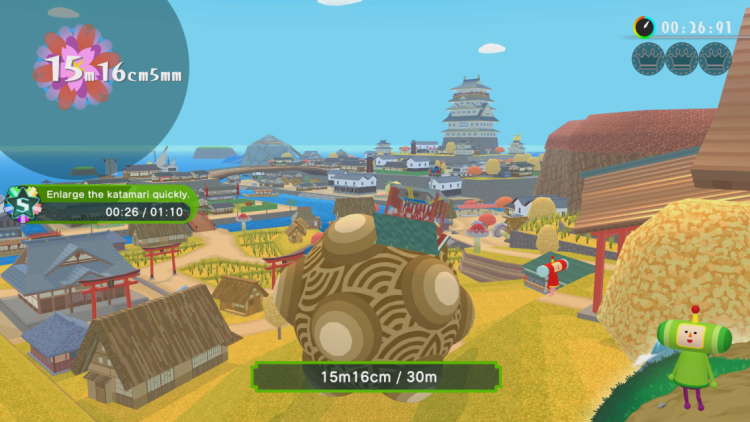
It matters that the game respects the effect without drowning in it. A project built on maximalist visuals and maximalist sound could easily overwhelm. The pacing avoids that trap. Levels breathe between crescendos. Smaller sounds punctuate dense passages. Music rarely overexplains mood; instead, it shapes momentum. When the screen fills with absurd life, the player feels lifted rather than pushed.
Structure beyond the campaign adds replay strength. Collectible cousins, unlockable gifts, and hidden crowns encourage revisits to earlier levels. Bonus stages open with enough frequency to reward curiosity. Difficulty never spikes into frustration, yet efficiency demands attention, creating an arc that rewards skill without punishing exploration. It will not stretch for dozens of hours, and that brevity helps rather than hurts. Katamari gains power through density, not duration.
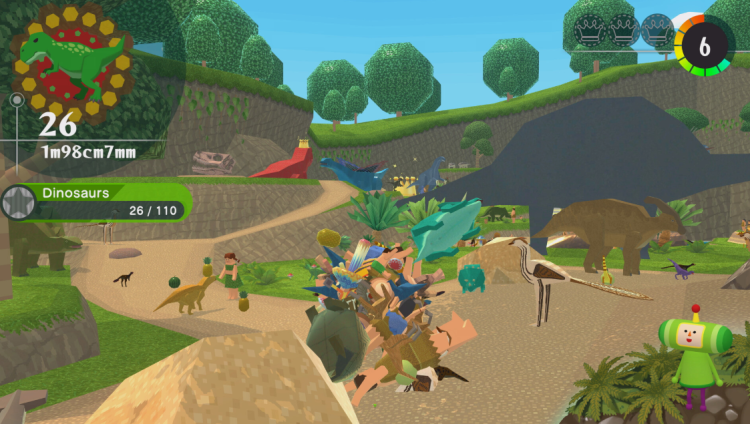
That design brings clarity to the broader creative stance. Rather than inflate scope in service of scale, the game commits to making every scene lively. Its worlds may be smaller than expansive modern sandboxes, yet they feel richer because no space lies empty. Texture emerges not from technical density but from density of intent.
There are limitations. Wacholz pointed out a concentration of stages in Edo-era Japan, leaving some eras underused and narrowing the time-travel premise in practice. The criticism is fair. When a concept promises nine or more periods, the imbalance becomes visible. While it does not undercut the experience, it does show the cost of focus: some settings feel brilliant and lived-in, while others pass quickly without the same imaginative imprint. The result is not monotony, but a missed opportunity to spread delight across the entire structure more evenly.
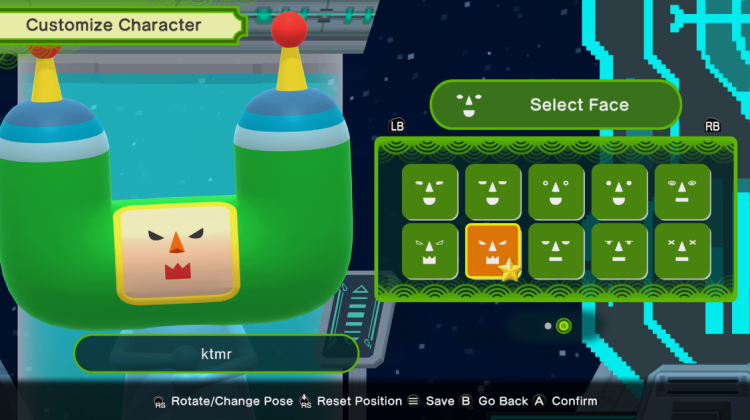
The soundtrack selector’s odd quirks also stand out. Grouping songs in loose eras rather than individual game playlists flattens the history a bit, and shuffle resets can lead to repetitive play. These are small interface blemishes rather than systemic flaws, yet detail matters in a project built on detail.
Performance, responsiveness, and input design feel tuned to the original spirit. The slightly awkward dual-stick navigation remains central by choice. refinement shows in early movement precision, where smaller katamari forms glide more easily than before. Once the ball swells, friction and inertia return to the familiar clumsy elegance. That subtle calibration honors history while embracing small adjustments to make learning more welcoming without softening the core.

What ultimately defines Once Upon A Katamari Review is its refusal to chase scale for its own sake. It does not attempt to compete with visual showpieces or open-world epics. Its horizon is narrower, yet in that narrowness the game finds clear purpose. It trusts the delight of rolling up a toothbrush, then a plant, then a scooter, then a building, then a city. The rhythm matters more than the escalation, and the quiet comedy in each object choice lands with precision because the developers resisted the temptation to dilute focus.
The result feels like a studio protecting a particular flavor of play. Rolling remains playful and absurd. Characters retain their mix of pomp and silliness. Music refuses to settle into one tone. Nothing here is loud for attention. The game flows with its own internal logic, which makes the moments of explosive scale more striking when they arrive.

During longer sessions, the effect becomes nearly meditative. The mind slips into pattern recognition. The grip on the controller lightens. A cascade of everyday items grows into a planetary mass while the soundtrack warbles and chirps in a way that feels both nostalgic and fresh. These are sensations most series struggle to produce once, much less across decades. That this new entry manages it without strain speaks to a maturity of design approach rarely seen in revivals.
Once Upon A Katamari Review watches the series return not simply intact, but self-assured. The charm is durable. The design still holds. The humor keeps its edge without drifting into self-parody. Minor structural imbalances and a few interface frustrations do not detract from the throughline. This is a light-footed, precisely judged revival, confident enough to resist overstatement and generous enough to let players discover pleasure rather than demand it.
Rolling through its worlds, one senses a quiet pride: a belief that the original idea deserved patience rather than overhaul. That belief pays off. Once Upon A Katamari stands as proof that sometimes the right move is not reinvention, but return with care. The universe it builds remains ridiculous and warm, and the process of consuming it object by object still carries the same strange calm.

Kommentarer